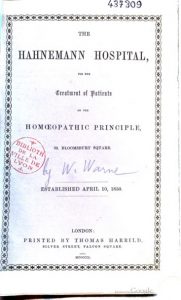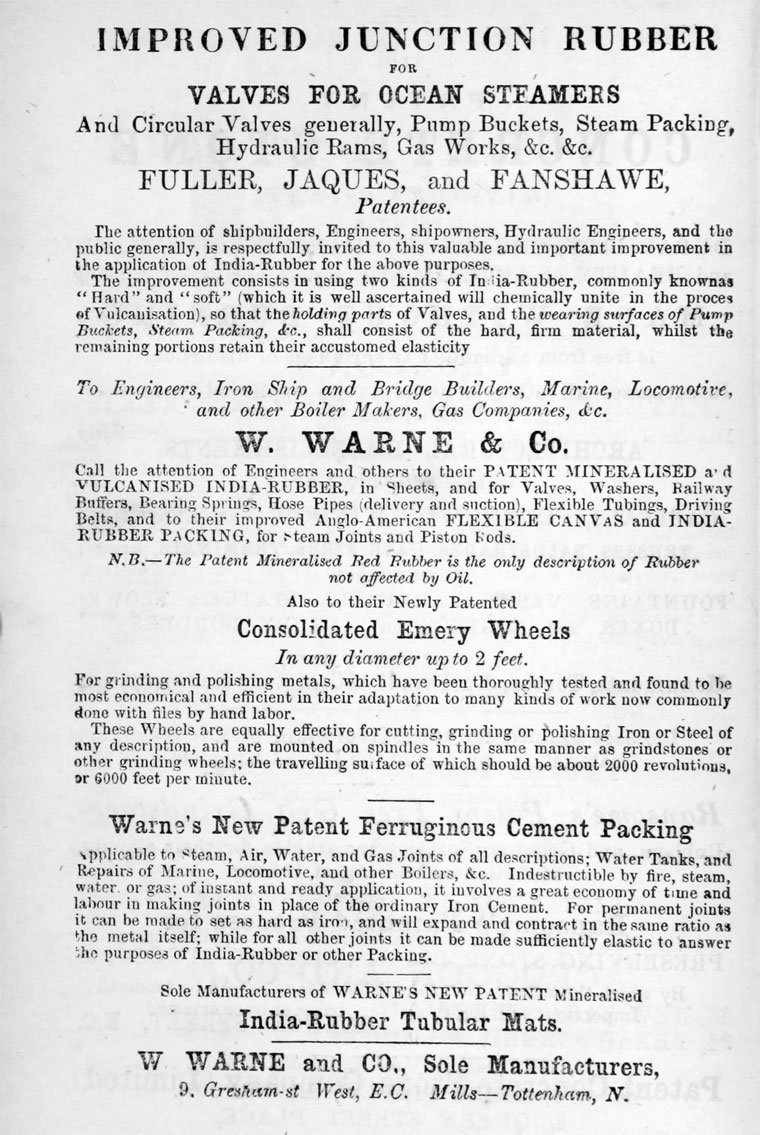 William Warne (21 July 1801 – 15 March 1861) was Honorary Secretary and Patron of the Hahnemann Hospital at 39 Bloomsbury Square. Warne was also on the Committee of the English Homeopathic Association, and Honorary Secretary to the London Homeopathic Medical Institution.
William Warne (21 July 1801 – 15 March 1861) was Honorary Secretary and Patron of the Hahnemann Hospital at 39 Bloomsbury Square. Warne was also on the Committee of the English Homeopathic Association, and Honorary Secretary to the London Homeopathic Medical Institution.
Paul Francois Curie treated Warne’s wife when she was suffering from a virulent form of small pox, and her recovery led to Warne becoming a staunch advocate of homeopathy.
William Warne knew the Staff of the Hahnemann Hospital at 39 Bloomsbury Square which included John Anderson, Christian Karl Josias Bunsen, John Chapman, Edward Charles Chepmell, Paul Francois Curie, Robert Ellis Dudgeon, Thomas Engall, Joseph Hands, Sydney Hanson, Edward Hamilton, Amos Henriques, Charles Hunt, Henry Kelsall, Joseph Laurie, Henry Victor Malan, James John Garth Wilkinson, David Wilson, William Leaf, George Wyld, Thomas Egerton 2nd Earl of Wilton, Robert Grosvenor 1st Baron Ebury, Thomas Roupell Everest, Charles Powell Leslie, James More Molyneux, William Henry Ashurst, William Thomas Berger, W A Case, J M Douglas, G H Flatcher, John Fowler, Joseph Glover, Thomas Higgs, T H Johnstone, John Miller, Chas Pasley, Mathias Roth, Frederick Sandoz, W Stephenson, Samuel Sugden, Allan Templeton, Major Tyndale, A Wilkinson, S Wilson and many others.
William Warne was born in St Leonards parish in Shoreditch in July 1801, to John Warne, a solicitor. In 1813, William and his brothers John and Charles Frederick attended the Merchant Taylor’s School.
Warne’s early adult activities are unclear but he had an aptitude for innovation. As an inventor he filed for his first patent in 1853. In 1854 he filed for a patent in the improvement of tubular steam boilers. Around this time Warne was listed as staying at Lower Blowing House, St. Austel, Cornwall although his primary residence since at least 1850 was in Tottenham, London at 9 Gresham Street West.
Warne was granted another patent in 1857 for the manufacture of ‘deckle straps’. In 1859, William Warne was granted another patent for ‘ferrous cement packing’.
By 1859 he was residing at Pembroke Terrace in Tottenham, where he had interest in a rubber factory owned by wealthy merchant and homeopathic supporter William Leaf. Originally founded in 1837 by Robert Sievier as the London Caoutchouc Company, a private enterprise for manufacturing rubber products, William Warne and Co, was established in 1850, when the company was bought by William Leaf who, named the company after its accountant, William Warne.
William Warne & Co., as manufacturers of India Rubber, had an early monopoly on the market, advertising that they were contractors to “Her Majesty’s Government, and to the principal English and Foreign Railways.”
Among his other concerns during the 1850s Warne was chairman of the Linares Lead Mining Company and a Dir ector for the new California Water Company, incorporated in 1856.
ector for the new California Water Company, incorporated in 1856.
William Warne was an avid collector of books, and he later lived at Grove House, Old Brompton, near London.
As secretary of the Hahnemann Hospital, Warne drafted the first published constitution for the hospital.
William Warne died prematurely from a “paralytic seizure” in March 1861 in Torquay, Devon and was buried in Newton Abbot, leaving his wife Clara Esther (1796 – 1867) and four children: George Frederick Spencer, Clara Helena, Charles John, and Henry H. Warne. Their eldest son, William Thompson Warne, had died, aged 19, in 1848.
Warne’s dedication to homeopathy in Britain during its early years was acknowledged in a brief but warm obituary given in the May edition of the 1861 British Homoeopathic Review: “We record his departure, because he was one of the real workers for the cause he believed in: HOMOEOPATHY. Let his memory be held in esteem.”
Of interest:
William Warne and Co Ltd., India rubber manufacturers in Tottenham. The company still exists today, renamed as Icon Aerospace Technology based in Retford, Nottinghamshire.



hi, does anybody have any photos of the 100th anniversary of william warnes factory in gascoigne road barking, essex.
My great grandfather, W.F.Cox worked for William Warne company for over 40 years! His son W.F.V.Cox became secretary of the rubber company in the 1920s and 1930s
My husband worked at William Warne (rubber company) Ltd for over 30 Years in Gascoigne road, barking Essex
I worked in the sales office at William Warne Limited from December 1978 until November 1988. I loved my job and left only because my personal circumstances were changing. I was always proud of the contribution WW made to the Ministry of Defence (probably 90% of my work there was with the MoD). I have a copy of a letter somewhere thanking us for our efforts during the Falklands conflict. For me – they were happy days.
I used to service and maintain all the lifts in William Warne throughout the 1970s 80s and 90s